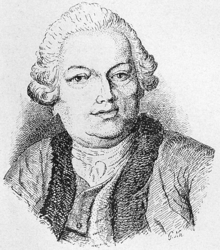Claude Bourgelat


Claude Bourgelat (27 March 1712 – 3 January 1779) was a French veterinary surgeon. He was a founder of scientifically informed veterinary medicine, and he created one of the earliest schools for training professional veterinarians.
Life and career[]
Bourgelat was born at Lyon. He initially studied law and worked as a barrister, but he became interested in veterinary medicine because of his interest in horses.[1]
In 1740, at the age of 28, Bourgelat became the head of the Lyon Academy of Horsemanship.[1] As an amateur horsemanship enthusiast, he developed a style of horse riding that is still in use.[2] In 1750 Bourgelat wrote a book on the topic of veterinary medicine, in which he considered the idea of founding a veterinary school.[1] He followed through on the idea in 1761 (also variously given as 1762 or 1764), when he co-founded the veterinary colleges at Lyon.[1] He founded the veterinary college specifically to combat the cattle plague (also called the rinderpest), and students trained at the Lyon veterinary college were credited with helping to cure the disease.[3]
Bourgelat was noted for being an early practitioner of scientifically informed veterinary medicine, which incorporated ideas from natural history, chemistry, clinical medicine, and comparative anatomy.[4]
Bourgalet was a member of the French Academy of Sciences and the Prussian Academy of Sciences. He also contributed to Diderot and d'Alambert's Encyclopédie.[5]
Selected works[]
- Élémens d'hippiatrique, ou, Nouveaux principes sur la connoissance et sur la médecine des chevaux (1750)
- L'art vétérinaire (1761)
- Matiere médicale raisonnée; ou, Précis des médicamens considérés dans leurs effets, a l'usage des éleves de l'Ecole royale vétérinaire; avec les formules médicinales. Lyon, Jean-Marie Bruyset (1765)
- Lehrbegriff der medicinischen Materie; oder, Beschreibung der einfachen Arzeneyen nach ihren Wirkungen; nebst den Medicinischen Formeln. Zum Gebrauche der Lehrlinge in der königl. Vieharzeneyschule zu Lyon. Aus dem Französischen übersetzt. Leipzig, M. G. Wiedmanns Erben und Reich (1766)
- Matiere médicale raisonnée, ou, Précis des médicamens considérés dans leurs effets. Lyon, Chez Jean-Marie Bruyset (1771)
- Elémens de l'art vétérinaire. Précis anatomique du corps du cheval, à l'usage des éleves des écoles vétérinaires. Paris, Vallat-la-Chapelle (1791)
See also[]
- Marc Mammerickx: Claude Bourgelat: avocat des vétérinaires, Bruxelles 1971
- Hugues Plaideux, « L'inventaire après décès de Claude Bourgelat », in Bulletin de la Société française d'histoire de la médecine et des sciences vétérinaires, 10, 2010, p. 125-158.on line
- Hugues Plaideux, « La descendance de Claude Bourgelat », in Bulletin de la Société française d'histoire de la médecine et des sciences vétérinaires, 12, 2012, p. 161-176. on line
- Bourgelat, Claude, in: Frank Arthur Kafker, The encyclopedists as individuals: a biographical dictionary of the authors of the Encyclopédie, Oxford 1988, ISBN 0-7294-0368-8, p. 67–71.
- Richard Tagand: Claude Bourgelat, écuyer lyonnais, 1712–1779, in: Revue de médecine vétérinaire 1959, p. 888–897.
- Alcide Railliet, Léon Moulé: Histoire de l'École d'Alfort, Paris 1908, online
- Louis Furcy Grognier: Notice historique et raisonnée sur C. Bourgelat, Fondateur des écoles vétérinaires; ou l'on trouve un aperçu statistique sur ces établissemens, Paris [u.a.] 1805
References[]
- ^ Jump up to: a b c d "Claude Bourgelat". Michigan State University. March 11, 2019. Retrieved 30 August 2020.
- ^ "Pioneering a profession: The birth of veterinary education in the Age of Enlightenment". American Veterinary Medical Association. December 19, 2010. Retrieved 30 August 2020.
- ^ J.L.Lupton, "Modern Practical Farriery", 1879, in the section: "The Diseases of Cattle Sheep and Pigs" pp. 1
- ^ Heintzman, Kit (2018). "A cabinet of the ordinary: domesticating veterinary education, 1766–1799" (PDF). The British Journal for the History of Science. 51 (2): 239–260. doi:10.1017/S0007087418000274. PMID 29665887.
- ^ Frank A. Kafker: Notices sur les auteurs des dix-sept volumes de « discours » de l'Encyclopédie. Recherches sur Diderot et sur l'Encyclopédie. 1989, Volume 7, Numéro 7, p. 133
| Wikimedia Commons has media related to Claude Bourgelat. |
This article incorporates text from a publication now in the public domain: Wood, James, ed. (1907). The Nuttall Encyclopædia. London and New York: Frederick Warne. Missing or empty |title= (help)
- 1712 births
- 1779 deaths
- People from Lyon
- French scientists
- Contributors to the Encyclopédie (1751–1772)
- Members of the French Academy of Sciences
- Members of the Prussian Academy of Sciences
- French veterinarians
- French male non-fiction writers
- 18th-century French male writers